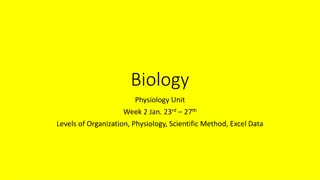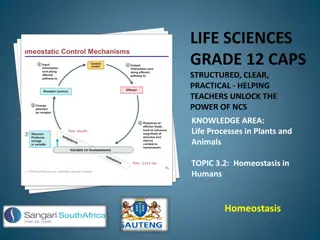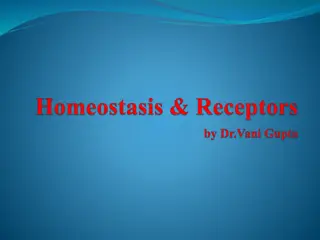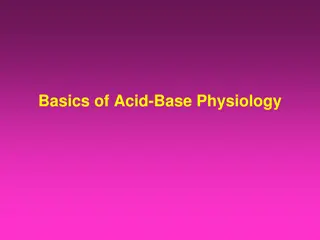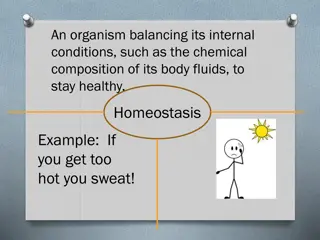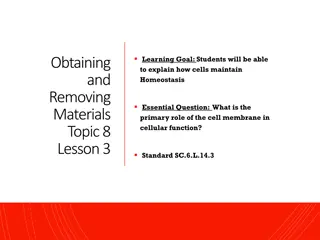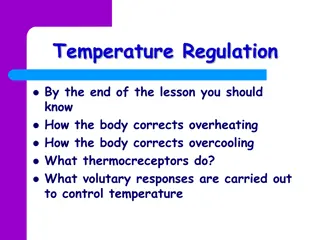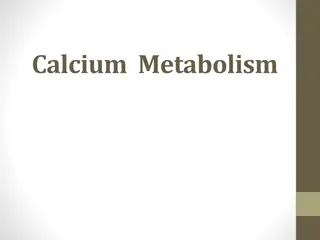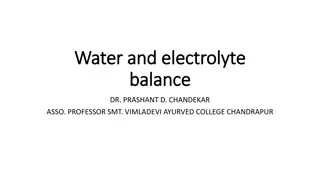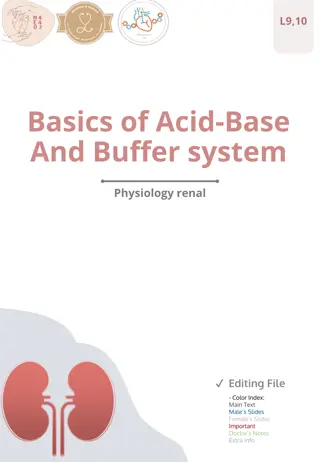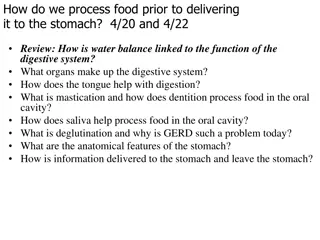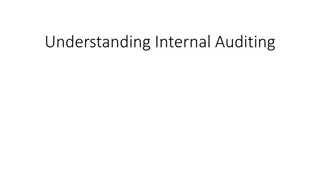Understanding Homeostasis: Maintaining Internal Balance in the Body
The concept of homeostasis is crucial for understanding how the body maintains a stable internal environment despite external fluctuations. This presentation covers the definitions of positive and negative feedback mechanisms, components of feedback loops, and the role of homeostatic mechanisms in physiological control. It highlights the importance of the internal environment, differences between external and internal environments, and the significance of maintaining homeostasis for overall health and well-being.
Download Presentation

Please find below an Image/Link to download the presentation.
The content on the website is provided AS IS for your information and personal use only. It may not be sold, licensed, or shared on other websites without obtaining consent from the author. Download presentation by click this link. If you encounter any issues during the download, it is possible that the publisher has removed the file from their server.
E N D
Presentation Transcript
Females & Males Slides Only Found in Males slides Only Found in Females slides PHYSIOLOGY Vary Important Notes Notes Extra Information
Homeostasis I Homeostasis I
Objectives At the end of this session, the students should be able to: Differentiate between positive and negative feedback mechanisms and give examples for each in the body. Define a feedback mechanism and describe its components. Explain how homeostatic mechanisms regulated by negative feedback detect and respond to environmental changes + Define positive and negative feedback Describe the actions of a positive feedback loop. Discuss the physiologic control mechanisms that enable maintenance of the normal steady state of the body. Define and discuss the concept of homeostasis and its importance to the living organism. Define the concept of the internal environment and state its physiologic importance. Differentiate between the external and internal environments. Study source for this lecture: (Guyton & Hall Textbook of Medical Physiology, 13th ed, Chapter 4)
All the cells in the body are continuously bathing in fluid , Because this fluid is outside the cell, it is called extracellular fluid (ECF). It is from the ECF that cells get the ions and nutrients needed to maintain life. All body cells live in the same environment (i.e. ECF). The composition of ECF is almost similar between the different species.
External vs Internal environment In Unicellular organisms In Multicellular organisms External environment Internal environment = External environment Internal environment
External vs Internal environment ECF = the internal environment. The skin separates this environment from the outside world which known as the external environment. 5
The process by which the body keeps the internal environment constant despite changes in the external environment is known as Homeostasis . Homeo- : sameness, similarity stasis: standing Essentially all the functions of the body organs and tissues aim at keeping the internal environment at a nearly constant state. Chemical, thermal, and neural factors interact to maintain homeostasis. -Hemostasis : Is the tendency to the internal balance or is the maintenance of nearly constant conditions in the internal environment.
The internal environment of the body (ECF) is in a dynamic state of equilibrium All different body systems operate in harmony to provide homeostasis Extreme dysfunction leads to death; moderate dysfunction leads to sickness. -Internal environment is always in dynamic state to maintain hemostasis
The body maintains homeostasis by using homeostatic control systems Three components associated with each system: 1-Receptor 2-control center 3-effector Receptor The structure that detects changes in a variable, the stimulus e.g., a change in temperature Consists of sensory nerves Control center The structure that interprets input from the receptor Initiates changes through the effector A portion of the nervous system or an endocrine organ Effector The structure that brings about change to alter the stimulus Most body structures. e.g., muscles or glands 2 2 1 1 3 3
Control center 3 Input: 4 Output: Information sent along afferent pathway to Information sent along efferent pathway to Effector Receptor (sensor) 2 Change detected by receptor Homeostatic Control Mechanisms Homeostatic Control Mechanisms 5 Response of effector feeds back to influence magnitude of stimulus and Stimulus: Produces change in variable 1 returns variable to homeostasis Variable (in homeostasis) 11
Nervous system: Controls and coordinates bodily activities that require rapid responses. Detects and initiates reactions to changes in external environment. e.g., regulation of blood pressure upon rising. - Response faster than endocrine system Endocrine system: Secreting glands of endocrine regulate activities that require duration rather than speed. e.g., parathyroid hormone regulating calcium levels. - Response slower than nervous system
Control systems Protection Skin Immune system Endocrine systems Nervous system O2 Internal environment CO2
Concentration of nutrient molecules. Ex: Glucose Concentration of water, salt, and other electrolytes Concentration of waste products Concentration of O2 = 100mmHg and CO2 = 40 mmHg pH = 7.35 Blood volume 4-6 L and pressure 120/80 Temperature = 37oC Body constituents are normally regulated within a range rather than a fixed value.
Response of a homeostatic system occurs through a feedback loop: Stimulus detection of stimulus by a receptor information relayed to the control center integration of the input by control center and initiation of change through effectors return of homeostasis by the actions of effectors
Negative feedback Positive feedback -Negative feedback loop original stimulus reversed. used for conditions that need frequent adjustment. Most feedback systems in the body are negative 1. The effector response of the system is in the opposite direction to the stimulus that initiated the response. E.g; A high level of in CO2 in the ECF will increase pulmonary ventilation, increasing the amount of CO2 expired which will bring the level of CO2 in ECF down. The effector response is in the same direction of the stimulus that initiated the response. E.g; In nerve signaling, entry of a small amount of Na+ into the cell will open more Na+ channels causing more Na+ to enter the cell. 2. 3. -Positive feedback loop original stimulus intensified. seen during normal childbirth. 1. Only few systems 2. Most of the control display positive feedback systems of the body act by mechanisms.. WHY? negative feedback.
Negative feedback A type of homeostatic control system that maintains the variable within a normal range Variable maintained within a normal level, its set point fluctuates around the set point If stimulus increases, homeostatic control system activated to cause a decrease in the stimulus If stimulus decreases, homeostatic control system activated to cause an increase in the stimulus
Examples of Negative Feedback Mechanisms Body temperature control
Positive feedback during breastfeeding Sensory detectors detect baby suckling Message is transmitted to the hypothalamus Hypothalamus signals posterior pituitary to release the hormone oxytocin Oxytocin stimulates the mammary gland to eject breast milk Cycle repeats as long as the baby suckles Other examples of positive feedback: blood clotting cascade uterine contractions of labor
Positive Feedback during Childbirth Stretch receptors in walls of uterus send signals to the brain Brain induces release of hormone (oxytocin) into bloodstream Uterine smooth muscle contracts more forcefully More stretch, more hormone, more contraction etc. Cycle ends with birth of the baby & decrease in stretch
Baroreceptors in walls of blood vessels detect an increase in BP. Brain receives input and signals from blood vessels and heart. Blood vessels dilate, HR decreases. BP decreases
Temperature regulation Body temperature drops Sensory receptors detect this and signal the hypothalamus (component of the brain) Hypothalamus alerts nerve impulses in blood vessels in the skin to decrease the inside opening of the vessels This decreases amount of amount of blood circulating to the surface of the body Less heat is released through skin Nerve impulses are sent to skeletal muscles, causing shivering Nerve impulses are sent to smooth muscles of hair follicles, causing goosebumps
Quiz ( 1 Quiz (Fill the boxes) Fill the boxes) body cells live in the same environment body cells live in the same environment Somatic Nerve Stimulus All Somatic Nerve Stimulus All 1) 2) 3) 4) 1) 2) 3) 4) 2
3 A structure that detects changes in a variable is called A structure that detects changes in a variable is called Stimulus Skin receptor None of these Stimulus Skin receptor None of these 1) 2) 3) 4) 1) 2) 3) 4) 4
5 ? ? Essentially all the functions of the organs and tissues aim at keeping the internal environment at a nearly constant state Essentially all the functions of the organs and tissues aim at keeping the internal environment at a nearly constant state Internal Body External Cardiovascular Internal Body External Cardiovascular 1) 2) 3) 4) 1) 2) 3) 4) 6
Question 1 2 3 4 5 6 answer 4 4 3 1 2 4 Slide number 4 7 7 14 5 20
Boys team members: Girls team members: Team Leaders: Team Leaders: - - - -


